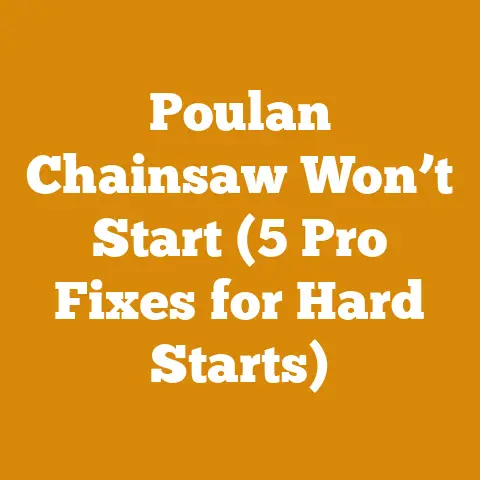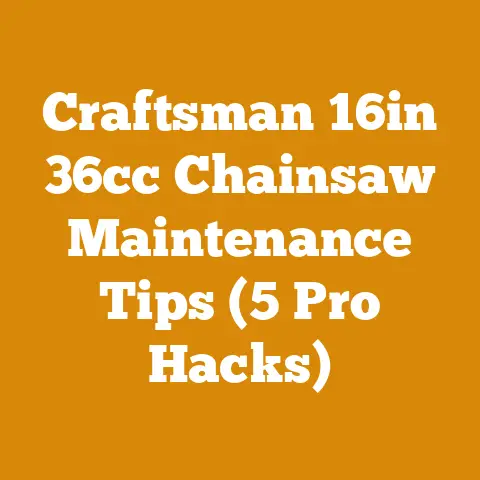Does Mud Blunt a Chainsaw? (Explained)
Chainsaws are powerful tools that can help you cut through wood quickly and efficiently.
However, when using a chainsaw, it’s important to keep the chain sharp and free of debris to maintain optimal performance.
A common question many chainsaw owners have is whether mud can blunt or dull a chainsaw chain over time.
How Mud Impacts a Chainsaw Chain
Mud contains tiny particles of dirt, sand, clay, and other materials that can be highly abrasive.
When these particles come into contact with your chainsaw chain at high speeds, they act like sandpaper, slowly grinding away the sharp cutters on the chain.
Over time, this abrasive action can rounded off the critical cutting edges, leading to significant dulling.
Additionally, as mud dries, it can clog the spaces between the drive links, further hampering chain performance and accelerating wear.
So while a small or one-time exposure to mud may not cause noticeable damage, repeated sawing in muddy conditions can definitely shorten the life of your chain.
Signs of a Blunt Chainsaw Chain
You don’t need to see large buildups of mud or debris to recognize when your chain is losing its edge.
Some telltale signs your chainsaw chain needs sharpening include:
Decreased cutting speed: A sharp chain can zip through wood smoothly and quickly.
As it dulls, you’ll need to apply more pressure and the saw will seem to bog down more during the cut.
More sawdust than chips: Blunt cutters produce tiny dust particles rather than larger, coarse wood chips.
Pay attention to the size and volume of the debris coming off the wood.
Burning smell: Friction from prolonged contact between a dull chain and wood can generate enough heat to burn the wood, producing an unpleasant smell.
Crooked cutting path: Following your intended cut line requires a sharp chain.
Chains that are slightly dull tend to wander and veer off course.
Fuel consumption goes up: It takes more power and longer run times to cut the same amount of wood with a dull chain.
You may notice an increase in refueling.
Chainsaw vibrates more: A sharp chain slices smoothly through wood.
But a dull or damaged chain creates more resistance, which translates into additional vibration of the saw.
By recognizing these signs as soon as they crop up, you can sharpen or replace your chain before extensive damage occurs.
Catching issues early also helps maximize safety.
Tips to Prevent Chain Dulling
While some dulling from normal use is inevitable, you can take proactive steps to prolong the sharpness and extend the lifespan of your chainsaw chain between sharpenings:
Choose the Right Chain Type
Chainsaw chains come in a variety of styles, materials, and designs to match different saws and cutting tasks.
Some are more resistant to abrasion and better at retaining an edge.
Do your research to select the best chain for your needs.
Hardened rivets also withstand mud better.
Keep It Lubricated
Run the saw at full throttle and allow the lubricating oil to freely flow along the chain.
This washes away debris while reducing friction.
Regular lubrication also helps combat rust.
Brush Off Debris
If possible, periodically brush off any mud, soil, or other buildup on the chain with a wire brush while the saw is running.
Keeping it clean prevents accumulations.
Make Precise Cuts
Sloppy cuts increase contact between the chain and surrounding wood or dirt.
Accurate cuts help the chain glide through cleanly without grinding on adjacent surfaces.
Sharpen Regularly
Routinely sharpening the chain as soon as performance drops off removes rounded cutters and restores the precisely honed edge needed.
Catch problems early.
Replace When Needed
Inspect chains periodically for cracked rivets, bent or broken drive links, and excess stretching.
These indicate replacement is needed.
Best Practices for Cutting in Muddy Conditions
Sometimes muddy conditions are unavoidable, like cutting up downed trees after a flood.
In these cases, be especially mindful:
Clear Away Excess Mud
Wipe off heavy debris from the wood first so your chain contacts mostly wood rather than abrasive mud.
Remove the buildup periodically.
Go Slow
Don’t rush the cut.
Allow the chain to slice instead of forcing it through quickly, which can accelerate wear from mud contact.
Watch for Wood With Embedded Grit
If the tree sucked up sandy soil or gravel when it fell, the abrasives become embedded.
This can dull chains faster than plain mud.
Dry Thoroughly When Done
Use compressed air or a leaf blower to remove all debris from the chain, bar, and saw body once finished cutting for the day.
Clean & Sharpen Chains Right Away
Don’t delay.
Used chains should be brushed off, inspected, then sharpened after extreme duty to restore their cutting potential.
FAQs: Chainsaw Chains & Mud
Still have some lingering questions about how mud impacts chainsaw chains and what to do about it?
Here are answers to some frequently asked questions:
Does mud damage chainsaw chains?
Yes.
The tiny abrasive particles in mud can grind away and erode the delicate cutting edges on chain teeth over time.
Continued operation with a mud-damaged chain also accelerates wear on the bar.
Should I clean the chain after cutting?
Absolutely.
Thoroughly remove all debris, sap, soil, and other gunk off the chain once you’re done sawing for the day or before storing.
This prevents buildup and corrosion.
How often should chains be sharpened?
Most professionals recommend sharpening after every 1-3 tankfuls of gas, depending on use.
Chains cutting extremely dirty or muddy wood may need sharpening after each use.
Learn what to look for.
Can I sharpen a chain myself?
With the proper files and guides, absolutely.
Many DIYers successfully hand sharpen their own chains.
However, the angles must be very precise, so there is a learning curve.
Electric or automatic grinders are simpler for beginners.
When should I replace a chain?
Replace any chain that is badly damaged, excessively stretched, or cannot be sharpened to like-new condition.
Bent, broken, or loose rivets also indicate replacement time.
With proper care, a high quality chain can last multiple sharpenings.
What are some chainsaw maintenance tips?
- Lubricate the bar and chain before each use
- Tension the chain properly
- Sharpen the chain regularly
- Replace worn sprockets
- Clean the air filter & saw body
- Inspect clutch drums and needle bearings
- Check the ON/OFF switch and throttle control
Keeping your saw well-maintained prevents many issues and is cheaper over the long run.
Conclusion
Mud may not destroy a chainsaw chain instantly, but it can definitively shorten chain life and dull your cutting edges faster – especially if you allow buildup or continue operating with damaged cutters.
Stay alert for signs of dulling, keep your chains properly cleaned and lubricated, and sharpen promptly when needed.
Your sawing performance and safety depends on it!
Implementing proactive maintenance habits allows you to get the most value from your chainsaw investment while trouble-free operation.
Just be sure to take extra precautions when you have to cut wood in muddy or dirty conditions.
With the right chain for your usage and some periodic TLC, you’ll keep your chainsaw chains happily cutting clean and fast for a long time.






